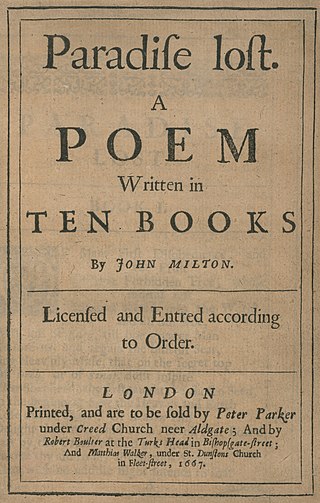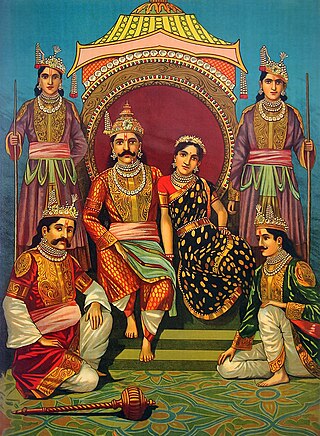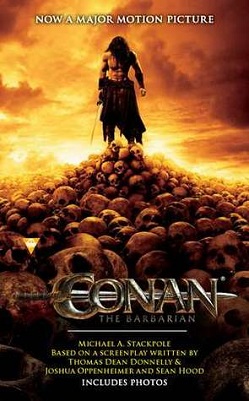
Conan the Barbarian is a fictional sword and sorcery hero who originated in pulp magazines and has since been adapted to books, comics, films, television programs, video games, and role-playing games. Robert E. Howard created the character in 1932 for a series of fantasy stories published in Weird Tales magazine.

Paradise Lost is an epic poem in blank verse by the 17th-century English poet John Milton (1608–1674). The first version, published in 1667, consists of ten books with over ten thousand lines of verse. A second edition followed in 1674, arranged into twelve books with minor revisions throughout. It is considered to be Milton's masterpiece, and it helped solidify his reputation as one of the greatest English poets of all time. The poem concerns the biblical story of the fall of man: the temptation of Adam and Eve by the fallen angel Satan and their expulsion from the Garden of Eden.

Sword and sorcery (S&S), or heroic fantasy, is a subgenre of fantasy characterized by sword-wielding heroes engaged in exciting and violent adventures. Elements of romance, magic, and the supernatural are also often present. Unlike works of high fantasy, the tales, though dramatic, focus on personal battles rather than world-endangering matters. The genre originated from the early-1930s works of Robert E. Howard. The term "sword and sorcery" was coined by Fritz Leiber in the 6 April 1961 issue of the fantasy fanzine Ancalagon, to describe Howard and the stories that were influenced by his works. In parallel with "sword and sorcery", the term "heroic fantasy" is used, although it is a more loosely defined genre.

Linwood Vrooman Carter was an American author of science fiction and fantasy, as well as an editor, poet and critic. He usually wrote as Lin Carter; known pseudonyms include H. P. Lowcraft and Grail Undwin. He is best known for his work in the 1970s as editor of the Ballantine Adult Fantasy series, which introduced readers to many overlooked classics of the fantasy genre.

Yudhishthira also known as Dharmaraja, was the king of Indraprastha and later the King of Kuru Kingdom in the epic Mahabharata. He is the eldest among the five Pandavas, and is also one of the central characters of the epic.

Ricardo Pinto is a computer game programmer and fantasy novelist.

"The Black Stranger" is a fantasy short story by American writer Robert E. Howard, one of his works featuring the sword & sorcery hero Conan the Cimmerian. It was written in the 1930s, but not published in his lifetime. When the original Conan version of his story failed to find a publisher, Howard rewrote "The Black Stranger" into a piratical Terence Vulmea story entitled "Swords of the Red Brotherhood".

Thulsa Doom is a fictional character created by American author Robert E. Howard, as an antagonist for the character Kull of Atlantis. Thulsa Doom debuted in the story "Delcardes' Cat". He has since appeared in comic books and film as the nemesis of Kull and, later, one of Howard's other creations, Conan the Barbarian.

The Chosen is a 1999 fantasy novel by Ricardo Pinto. It is the first book in The Stone Dance of the Chameleon trilogy, which concerns the harrowing experiences of the young and inexperienced heir to a ruling dynasty who is suddenly taken from his protected childhood and thrust into a cruel society where he must fight for his family honour, his position and his life. A 2000 Locus poll ranked The Chosen 14th in the Best First Novel category.

The Standing Dead is a 2002 fantasy novel by Ricardo Pinto. It is the second book in The Stone Dance of the Chameleon trilogy, which concerns the harrowing experiences of the young and inexperienced heir to a ruling dynasty who is suddenly taken from his protected childhood and thrust into a cruel society where he must fight for his family honour, his position and his life.

Conan the Barbarian is a 1982 American epic sword-and-sorcery film directed by John Milius and written by Milius and Oliver Stone. Based on Robert E. Howard's Conan, the film stars Arnold Schwarzenegger and James Earl Jones, and tells the story of a barbarian warrior named Conan (Schwarzenegger) who seeks vengeance for the death of his parents at the hands of Thulsa Doom (Jones), the leader of a snake cult.

The Carnelian Cube is a science-fantasy novel by American writers L. Sprague de Camp and Fletcher Pratt. It was first published in hardcover by Gnome Press in 1948, and in paperback by Lancer Books in 1967. An E-book edition was published by Gollancz's SF Gateway imprint on September 29, 2011 as part of a general release of de Camp's works in electronic form. It has also been translated into Italian and German.

Conan of Aquilonia is a collection of four linked fantasy short stories by American writers L. Sprague de Camp and Lin Carter featuring Robert E. Howard's sword and sorcery hero Conan the Barbarian. The stories were originally published in Fantastic in August 1972, July 1973, July 1974, and February 1975. The collected stories were intended for book publication by Lancer Books, but this edition never appeared due to Lancer's bankruptcy, and the first book edition was issued in paperback by Ace Books in paperback in May 1977. It was reprinted by Ace in July 1981, April 1982, November 1982, August 1983, July 1984, 1986, June 1991, and April 1994. The first British edition was published by Sphere Books in October 1978, and reprinted in July 1988. The book has also been translated into French.
Adrian Christopher Synnot Cole, is a British writer. He is known for his Dream Lords trilogy, the Omaran Saga and Star Requiem series, and his young adult novels, Moorstones and The Sleep of Giants.

Conan the Adventurer is an American television live-action-adventure series. It was produced by Max A. Keller and Micheline Keller from 1997 to 1998 and was loosely based on the fantasy hero Conan the Barbarian.

Royal Exile is the first novel in the Valisar trilogy, by Australian fantasy author Fiona McIntosh. It was first published in September 2008 by HarperVoyager Royal Exile follows the story of Leo, a young Valisar Royal whose world is destroyed by the Barbarian, Loethar, as he attempts to win back his throne and rid his land of the evil barbarian horde. The story is continued in A Tyrant's Blood.

"A Witch Shall Be Born" is one of the original sword and sorcery novellas by Robert E. Howard about Conan the Cimmerian. It was written in only a few days in spring of 1934 and first published in Weird Tales in December 1934. A book edition was published in 1975 by Donald M. Grant, Publisher with illustrations by Alicia Austin.

Conan the Barbarian is a fantasy novel written by Michael A. Stackpole featuring Robert E. Howard's seminal sword and sorcery hero of the same name, a novelization of the feature film of the same name. It was first published in paperback by Berkley Books in 2011. An earlier novel of the same name by L. Sprague de Camp, Lin Carter and Catherine Crook de Camp, based on the original film of which the 2011 version was a remake, was published by Bantam Books in 1982.

Conan and the Grim Grey God is a fantasy novel written by American writer Sean A. Moore, featuring Robert E. Howard's sword and sorcery hero Conan the Barbarian. It was first published in trade paperback by Tor Books in November 1996; a regular paperback edition followed from the same publisher in November 1997.


















